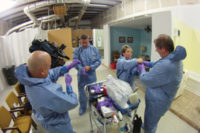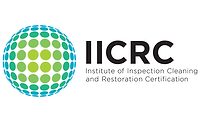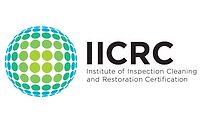The ANSI/IICRC S540-2017 Standard for Trauma & Crime Scene Cleanup (S540-2017) describes the procedures to be followed and the precautions to be taken when performing trauma and crime scene cleanup. As described in the standard, trauma and crime scene cleanup consists of the following components:
- Principles of trauma and crime scene cleanup
- Safety and health
- Biocide and antimicrobial technology
- Administrative procedures, documentation and risk management
- Inspection and preliminary determination
- Equipment and tools
- Limitations, complexities, complications and conflicts
- Structural remediation
- Vehicle and machinery construction
- Contents remediation
- Containment and disposal of waste or sharps
- Confirmation of cleanliness
While the S540-2017 is an American National Standard and is U.S.-based, it was written to be inclusive internationally. Regulations and regulatory agencies from Australia, the U.K. and Canada are cited in an effort to aid international users of the standard.
The S540-2017 is written for those involved in trauma and crime scene cleanup, primarily for restoration companies, their employees, technicians and other workers; and, secondarily, for other materially interested parties. It was not written as an instructional manual for teaching cleaning and disinfection methods, but rather to establish operational parameters.
Highlights of the S540-2017 include:
- Health and safety issues are described, including selecting the proper PPE – suits, boots, gloves, eye protection and respirators.
- Processes are outlined and the selection, use and storage of antimicrobials are covered in depth.
- Contamination is defined as well as details on how to safely handle various materials. Containment for both biological isolation and as a visual barrier are discussed.
- Devices for locating blood are discussed, as are cleaning and measuring cleaning effectiveness and how to package and dispose of regulated biohazardous waste.
- Dealing with clients recovering from the emotional and psychological trauma of a lost loved one, as well as the often overlooked psychological impact this work can have on technicians and workers are addressed.
S540-2017 Background
Deciding on the name of the standard was interesting because of the varying terminology used in the industry. For instance, the industry recognizes a variety of names for the process of cleaning up human blood and body fluids (e.g. biorecovery, forensic restoration, bioremediation, trauma scene restoration). The CB decided that in an effort to not offend any particular group, they would use a generic and explicit term, “Trauma and Crime Scene Cleanup.”
Initially, the CB considered whether the standard should include other biological hazards, such as disease outbreaks or contamination events related to non-blood-related disease-causing microbes, such as Ebola, Anthrax and Clostridium difficile (C. diff). The CB decided not to go in that direction, as it would be beyond the original intent and scope of the project.
The CB identified two skill levels: technician and worker. Technician is defined as a person who demonstrates the proper knowledge in trauma and crime scene cleanup from training and experience in order to restore the worksite to a safe and healthy condition. Worker is a person who has basic skill sets and safety training and can perform tasks under the direction of a technician, worksite superintendent, or supervisor.
Making the S540
Recruitment for the S540 Consensus Body members began in 2010 and the team began meeting in 2011. Made up of the brightest minds in not only trauma and crime scene cleanup, but the restoration industry as a whole, the committee worked hard to ensure the information conveyed was concise, easy to understand and represented a consensus across our industry.
After nearly six years, the S540-2017 was approved and published as an American National Standard (ANS). While the compilation of the information contained in the standard took many years, it paid off in the speed in which it passed through the public review period, needing only a handful of minor editorial adjustments.
The S540-2017 is a living document. It is subject to change as more information becomes available and advances occur. The standard will be reviewed, evaluated and validated through application in the field, and thereafter revised and improved. This process and further professional and public review allows the industry to develop a body of science and achieve the overall IICRC goal of improving the environments in which people live and work. Users of the S540-2017 should stay updated and informed about new developments, and implement changes as needed in order to stay compliant.
The ANSI/IICRC S540-2017 Standard is now available on both the IICRC webstore and the Standards Subscription website.




Report Abusive Comment